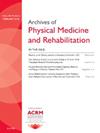Preliminary Assessment of Novel Upper Extremity Robotic Rehabilitation Tool on Upper Extremity Motor Control in Individuals with Chronic Neurologic Injuries: A Case Series Study
IF 3.6
2区 医学
Q1 REHABILITATION
Archives of physical medicine and rehabilitation
Pub Date : 2025-04-01
DOI:10.1016/j.apmr.2025.01.080
引用次数: 0
Abstract
Objectives
To investigate feasibility, safety, and clinical outcomes in individuals with chronic neurologic injuries with the use of the Harmony ScapuloHumeral Rhythm robotic device.
Design
Case Series.
Setting
Outpatient Rehabilitation Clinic.
Participants
The first 3 individuals with chronic neurologic injuries enrolled in an ongoing clinic research project were assessed: 1 with stroke, 1 with traumatic brain injury (TBI), and 1 with Guillain-Barre syndrome (GBS).
Interventions
The Harmony ScapuloHumeral Rhythm (SHR) robotic is a therapeutic robotic device to facilitate upper extremity motor return, while providing adjustable parameters for speed, amount of assistance, and body weight support. The device allows for full upper extremity movement, including scapular movement, and encourages appropriate scapulo-thoracic rhythm. Participants underwent 8-10 sessions, each including 40 minutes of physical therapy incorporating the SHR device. During the sessions, participants used 3 different SHR treatment modes: predefined exercise (passive or active-assisted), consisting of preprogrammed movement patterns; bilateral sync (passive or active-assisted) where the unaffected upper extremity drives the affected upper extremity's movement; and active freeform (active or active-assisted), where the participant moves both arms freely with machine support and adjustable assist level.
Main Outcome Measures
Assessments included: a 10-point Likert pain scale; goniometer-measured active range of motion (ROM) consisting of shoulder flexion and abduction and elbow flexion and extension; and the Modified Ashworth Scale (MAS) for all upper extremity (UE) joints. Outcomes were assessed at baseline and postintervention.
Results
For stroke-1, active ROM increased by 85° for shoulder flexion, 75° for abduction, 10° for elbow flexion, 55° for extension, and total MAS decreased from 3 to 1 for all joints in the affected UE. For TBI-1, active ROM increased by 6° for right UE shoulder flexion and 10° for left UE elbow extension and total MAS decreased 8 to 4 for left UE and 18 to 15 for right UE. For GBS-1, total active ROM increased by 1° for right UE and 5° for left UE shoulder flexion, 16° for left UE elbow extension, and no change in MAS because no spasticity reported. Only GBS-1 reported average pain with a decrease from 4 of 10 to 3 of 10 after intervention.
Conclusions
The Harmony SHR demonstrates promise in the treatment of persistent upper extremity dysfunction after neurologic injury. Data collection is ongoing, and the results of this pilot study will be used to develop a larger proposal assessing clinical efficacy. Future exploration should assess the ability to limit maladaptive plasticity and secondary complications associated with long-term decreased upper extremity impairment.
Disclosures
none.
求助全文
约1分钟内获得全文
求助全文
来源期刊
CiteScore
6.20
自引率
4.70%
发文量
495
审稿时长
38 days
期刊介绍:
The Archives of Physical Medicine and Rehabilitation publishes original, peer-reviewed research and clinical reports on important trends and developments in physical medicine and rehabilitation and related fields. This international journal brings researchers and clinicians authoritative information on the therapeutic utilization of physical, behavioral and pharmaceutical agents in providing comprehensive care for individuals with chronic illness and disabilities.
Archives began publication in 1920, publishes monthly, and is the official journal of the American Congress of Rehabilitation Medicine. Its papers are cited more often than any other rehabilitation journal.

 求助内容:
求助内容: 应助结果提醒方式:
应助结果提醒方式:


